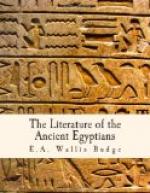Another late work of considerable interest is the “Book of Traversing Eternity,” the fullest known form of which is found on a papyrus at Vienna. This work describes how the soul of the deceased, when armed with the power which the Book of Traversing Eternity will give it, shall be able to travel from one end of Egypt to the other, and to visit all the holy places, and to assist at the festivals, and to enjoy communion not only with the gods and spirits who assemble there, but also with its kinsfolk and acquaintances whom it left behind alive on the earth. The object of the book was to secure for the deceased the resurrection of his body; it opens with the following words: “Thy soul liveth in heaven in the presence of Ra. Thy Ka hath acquired the divine nature of the gods. Thy body remaineth in the deep house (i.e. tomb) in the presence of Osiris. Thy spirit-body becometh glorious among the living. Thy descendants flourish upon the earth, in the presence of Keb, upon thy seat among the living, and thy name is stablished by the utterance of those who have their being through the ‘Book of Traversing Eternity.’ Thou comest forth by day, thou art joined to the Sun-god Aten.” The text goes on to state that the deceased breathes, speaks, eats, drinks, sees, hears, and walks, and that all the organs of his body are in their proper places, and that each is performing its proper functions. He floats in the air, hovers in the shadow, rises in the sky, follows the gods, travels with the stars, dekans, and planets, and moves about by night and by day on earth and in heaven at will.
Of the works that were originally composed for recitation on the days of the festivals of Osiris, and were specially connected with the cult of this god, three, which became very popular in the Graeco-Roman period, may be mentioned. These are: (1) The Lamentations of Isis and Nephthys; (2) The Festival Songs of Isis and Nephthys; (3) The Book of making splendid the Spirit of Osiris. The first of these works was recited on the twenty-fifth day of the fourth month of the season Akhet (October-November) by two “fair women,” who personified Isis and Nephthys. One of these had the name of Isis on her shoulder, and the other the name of Nephthys, and each held a vessel of water in her right hand, and a “Memphis cake of bread” in her left. The object of the recital was to commemorate the resurrection of Osiris, and if the book were recited on behalf of any deceased person it would make his spirit to be glorious, and stablish his body, and cause his Ka to rejoice, and give breath to his nostrils and air to his throat. The two “fair women” sang the sections alternately in the presence of the Kher-heb and Setem priests. The two first sections, as they are found on a papyrus in Berlin, read thus:—ISIS SAITH: “Come to thy house, come to thy house, O An, come to thy house. Thine enemy [Set] hath perished. O beautiful youth, come to thy house. Look thou upon me. I am the sister who loveth




